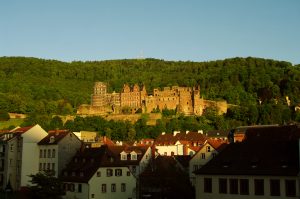Heidelberg is a city located in southwestern Germany, along the canals of the Neckar River. It was first recognized in 1196. It was the capital city of the Rhenish Palatinate. Later, it became the place of residence of the electorate counts palatine up to 1720.
The city was devastated during the Thirty Years’ War in 1622. It was almost completely wiped out by the French in 1689 and 1693.
Heidelberg is a university town. Its 2016 census revealed that it has a population of 159,914, with roughly a quarter of that figure are students.
It is the fifth-largest city in Baden-Wurttemberg.
The oldest university in Germany and one of Europe’s most reputable universities is in this city, the Heidelberg University, which was founded in 1386. The university played a leading role in the era of humanism and Reformation.
The city’s library is the oldest existing public library in Germany, it was established in 1421. A few months after announcing his Ninety-five Theses, Martin Luther came to Heidelberg to defend them, that was in April of 1518.
During World War II, the city was the stronghold of the Nazi party. Between 1933 and 1945 was known as the Nazi period.
In 1934-1935 the State Labor Service and students at Heidelberg University built the Thingstätte Amphitheater in the northern part of the town. This amphitheater was where Nazi Party events were held. After just a few months, the sprawling Ehrenfiedhof Memorial Cemetery was opened, which completed the last project of the Nazi Party in the city. It was in the southern part of the old town.
German troops left the city on March 29, 1945, after destroying the old bridge, the city’s valued river crossing. Allied forces penetrated the town the next day and the civilian population voluntarily surrendered.
It was said that the city was not targeted by Allied bombing raids because the U.S. Army wanted to use it as a post-war garrison.
The city is known as the scientific hub in Germany as there are some internationally renowned research labs near Heidelberg University, including Max Planck Institutes and the European Molecular Biology Laboratory.
For centuries it has been an art hub, especially literature. The UNESCO Creative Cities Network even awarded it as a “City of Literature”.
The city is a favorite tourist destination because of its popular romantic cityscape, including The Philosopher’s Walk, the old Baroque town, and the Heidelberg Castle.
The popular landmark, Heidelberg Castle ruins are among the most important Renaissance buildings located north of the Alps. it was demolished in the 17th and 18th centuries and has only been rebuilt partially. The castle is a towering figure from the Konigstuhl hillside. Visitors can go there via the Heidelberger Bergbahn funicular railway which runs from Kornmarkt all the way to the summit of the Kongistuhl.
The earliest castle structure was built before 1214. A second structure was built in 1294. In 1537, though, a lightning bolt struck and destroyed the upper castle.
The present structures were improved in 1650, unfortunately, wars and fires destroyed these structures. Portions were rebuilt but another lightning bolt struck in 1764.
You can visit Heidelberg and her castle from most Rhine River Cruises. We offer from 4 – 15 day cruises. Checkout our website for cruise itineraries. Contact us for more information and current promotions: 888-869-7907 or jan@europeanbarging.com

